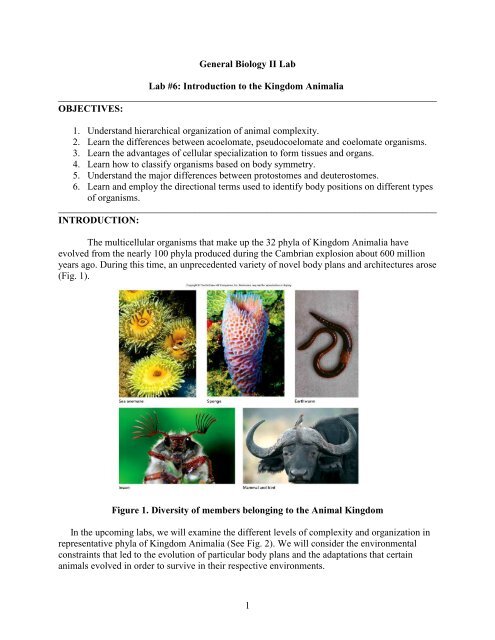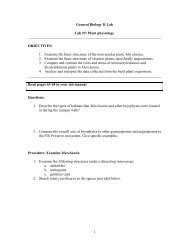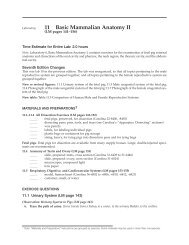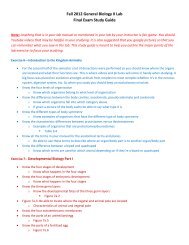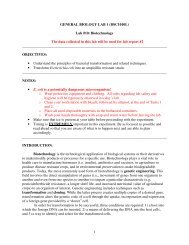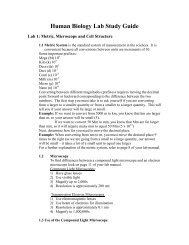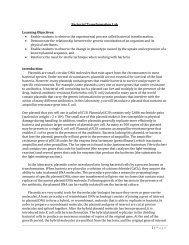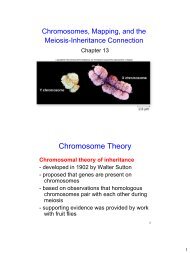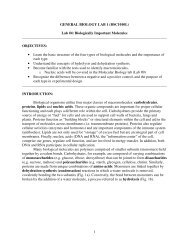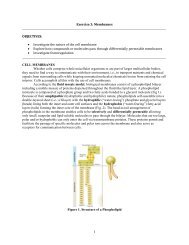Lab #7: Introduction to the Kingdom Animalia
Lab #7: Introduction to the Kingdom Animalia
Lab #7: Introduction to the Kingdom Animalia
Create successful ePaper yourself
Turn your PDF publications into a flip-book with our unique Google optimized e-Paper software.
General Biology II <strong>Lab</strong><br />
<strong>Lab</strong> #6: <strong>Introduction</strong> <strong>to</strong> <strong>the</strong> <strong>Kingdom</strong> <strong>Animalia</strong><br />
______________________________________________________________________________<br />
OBJECTIVES:<br />
1. Understand hierarchical organization of animal complexity.<br />
2. Learn <strong>the</strong> differences between acoelomate, pseudocoelomate and coelomate organisms.<br />
3. Learn <strong>the</strong> advantages of cellular specialization <strong>to</strong> form tissues and organs.<br />
4. Learn how <strong>to</strong> classify organisms based on body symmetry.<br />
5. Understand <strong>the</strong> major differences between pro<strong>to</strong>s<strong>to</strong>mes and deuteros<strong>to</strong>mes.<br />
6. Learn and employ <strong>the</strong> directional terms used <strong>to</strong> identify body positions on different types<br />
of organisms.<br />
______________________________________________________________________________<br />
INTRODUCTION:<br />
The multicellular organisms that make up <strong>the</strong> 32 phyla of <strong>Kingdom</strong> <strong>Animalia</strong> have<br />
evolved from <strong>the</strong> nearly 100 phyla produced during <strong>the</strong> Cambrian explosion about 600 million<br />
years ago. During this time, an unprecedented variety of novel body plans and architectures arose<br />
(Fig. 1).<br />
Figure 1. Diversity of members belonging <strong>to</strong> <strong>the</strong> Animal <strong>Kingdom</strong><br />
In <strong>the</strong> upcoming labs, we will examine <strong>the</strong> different levels of complexity and organization in<br />
representative phyla of <strong>Kingdom</strong> <strong>Animalia</strong> (See Fig. 2). We will consider <strong>the</strong> environmental<br />
constraints that led <strong>to</strong> <strong>the</strong> evolution of particular body plans and <strong>the</strong> adaptations that certain<br />
animals evolved in order <strong>to</strong> survive in <strong>the</strong>ir respective environments.<br />
1
In general, members of <strong>Kingdom</strong> <strong>Animalia</strong> are eukaryotic, multicellular, motile (at least<br />
during certain developmental stages), heterotrophic and unlike plants, lack a cell wall.<br />
Additionally, most animals reproduce sexually and have a characteristic pattern of embryonic<br />
development. Similar <strong>to</strong> alternation of generations observed in previous phyla, organisms in <strong>the</strong><br />
Animal kingdom undergo stages of development, starting from <strong>the</strong> fusion of an egg and a sperm<br />
and ending with a multicellular adult phase. While <strong>the</strong> morphology of <strong>the</strong> adult organism is<br />
highly species-specific, <strong>the</strong> genes that regulate organismal development are often conserved<br />
across species. In addition, <strong>the</strong> life cycles of members of <strong>Kingdom</strong> <strong>Animalia</strong> vary considerably,<br />
i.e., <strong>the</strong> stages may look completely different from each o<strong>the</strong>r (metamorphosis), <strong>the</strong>y may last<br />
for different periods of time (hours vs. years) and can occur in different habitats (e.g. dragonflies<br />
- adults live in air while larvae are aquatic).<br />
Figure 2. Phylogenetic tree of members of <strong>Kingdom</strong> <strong>Animalia</strong><br />
______________________________________________________________________________<br />
Task 1: Understanding <strong>the</strong> hierarchical organization of animal complexity<br />
The common descent of animals within <strong>Kingdom</strong> <strong>Animalia</strong> can be observed in <strong>the</strong><br />
organization of body plans and <strong>the</strong> fundamental building blocks that all animals share. Unique<br />
and shared characteristics among members of <strong>the</strong> animal kingdom are convincing evidence that<br />
<strong>the</strong> group is monophyletic (i.e. a group that shared a common ances<strong>to</strong>r and all its members). The<br />
2
hierarchiral level of organization of animals is cell, tissue, organ and organ system. <strong>Animalia</strong> is<br />
divided in<strong>to</strong> two main branches—<strong>the</strong> Parazoa and <strong>the</strong> Eumetazoa. Parazoans, like sponges,<br />
mostly lack any true symmetry and tissues. Eumetazoans, on <strong>the</strong> o<strong>the</strong>r hand, have definite<br />
symmetry and tissues. Most eumetazoans have complex arrangements of cells and tissues in<strong>to</strong><br />
organs and organ systems. The nerve net of jellyfish is a good example of cell-tissue<br />
organization (Fig. 6.3).<br />
Following in complexity is <strong>the</strong> tissue-organ level of organization, produced when<br />
different types of tissues combine <strong>to</strong> form organs. In general, organs perform more specialized<br />
and complex functions than tissues and can be composed of different tissue types (e.g. <strong>the</strong> heart,<br />
which is composed of cardiac muscle, epi<strong>the</strong>lial, connective and nervous tissues). This level of<br />
organization is observed exclusively in eumetazoans, most of which also exhibit an organ-system<br />
level of organization, where multiple organs operate <strong>to</strong>ge<strong>the</strong>r, forming a system that has a<br />
specific function (Fig. 3). In eumetazoans, <strong>the</strong>re are eleven organ systems: skeletal, muscular,<br />
integumentary, digestive, respira<strong>to</strong>ry, circula<strong>to</strong>ry, excre<strong>to</strong>ry, nervous, endocrine, immune and<br />
reproductive. We will examine some of <strong>the</strong>se systems in greater depth during <strong>Lab</strong>s 8-11.<br />
Figure 3. Hierarchical organization<br />
3
The major patterns of organization of animal complexity are described below in Table 1.<br />
As you examine <strong>the</strong> organisms <strong>to</strong>day, note which level of organization is present in each. Make<br />
sure <strong>to</strong> sketch <strong>the</strong> organisms listed for each level of organization, noting <strong>the</strong> phylum, genus and<br />
species of each.<br />
______________________________________________________________________________<br />
Task 1: Understanding <strong>the</strong> hierarchical level of organization of animal complexity<br />
Table 6.1<br />
Level of<br />
organization<br />
Cellular Cell-tissue Tissue-organ Organsystem<br />
Description<br />
Aggregation of<br />
cells that are<br />
functionally<br />
differentiated.<br />
Cells are<br />
aggregated in<strong>to</strong><br />
patters/layers =<br />
tissues.<br />
Different tissues<br />
are organized in<strong>to</strong><br />
organs; more<br />
specialized than<br />
tissues.<br />
Organs work<br />
<strong>to</strong>ge<strong>the</strong>r as a<br />
system <strong>to</strong><br />
perform a<br />
coordinated<br />
function<br />
Representative<br />
group<br />
Parazoa Radiata Bilateria Bilateria<br />
Example:<br />
a. phylum<br />
b. genus<br />
c. common name<br />
a. Porifera<br />
b. Grantia<br />
c. Sponges<br />
a. Cnidaria<br />
b. Metridium<br />
c. Sea anemone<br />
a. Platyhelmin<strong>the</strong>s<br />
b. Dugesia<br />
c. Planarian<br />
a. Chordata<br />
b. Perca<br />
c. Perch<br />
Drawing of<br />
whole organism<br />
Note: Do NOT dissect <strong>the</strong> Planarian or <strong>the</strong> Perch!<br />
4
Questions:<br />
1. Can you suggest why, during <strong>the</strong> evolution of separate animal lineages, <strong>the</strong>re has been a<br />
tendency for complexity <strong>to</strong> increase when body size increases<br />
2. Sponges have folded walls. What advantage could this trait have for <strong>the</strong> sponge<br />
3. What o<strong>the</strong>r organisms or organ systems possess similar folded structures<br />
a. What advantages does folding provide for <strong>the</strong>se organisms<br />
______________________________________________________________________________<br />
Task 2: Differentiating between acoelomate and coelomate organisms<br />
A major developmental event in bilaterally symmetrical organisms (see Task 3) was <strong>the</strong><br />
development of a fluid filled cavity (coelom) between <strong>the</strong> outer body wall and <strong>the</strong> gut. The<br />
coelom created a tube-within-tube arrangement allowing space for visceral organs and an<br />
increase in overall body size (Why). This structure also provides support and aids in<br />
movement/burrowing in some animals. However, not all organisms are coelomates; some lack a<br />
coelom al<strong>to</strong>ge<strong>the</strong>r and are called acoelomate (a = without) while o<strong>the</strong>rs are characterized by a<br />
pseudocoelom (pseudo = false). All three types of body cavities are illustrated below in Figure<br />
4.<br />
5
Figure 4. Types of body cavities<br />
6
Examine <strong>the</strong> organisms listed in Table 2 and complete <strong>the</strong> missing sections.<br />
Table 6.2<br />
Sample Organism Acoelomate Pseudocoelomate Coelomate<br />
Phylum Platyhelmin<strong>the</strong>s Nema<strong>to</strong>da Annelida<br />
Genus Dugesia Ascaris Lumbricus<br />
Common name Flatworms, planaria Roundworms Segmented worms,<br />
Earthworms<br />
Drawing of<br />
Cross section<br />
(slide)<br />
Only dissect <strong>the</strong><br />
Ascaris, <strong>the</strong> rest<br />
you can just draw<br />
as a whole<br />
organism<br />
Questions:<br />
1. Looking at <strong>the</strong> three representative specimens, what is <strong>the</strong> main difference between<br />
coelomate, pseudocoelomate and acoelomate organisms<br />
9
2. How are <strong>the</strong> organs and tissues organized differently in coelomates and acoelomates<br />
3. Is <strong>the</strong> Ascaris you dissected, male or female<br />
a. How can you tell<br />
______________________________________________________________________________<br />
Task 3: Body plans and symmetry<br />
While <strong>the</strong> diversity of animal forms is great, <strong>the</strong> basic body plans can be categorized by<br />
<strong>the</strong> presence and type of body symmetry (Fig. 5). Symmetry refers <strong>to</strong> <strong>the</strong> correspondence in size<br />
and shape between opposite sides of an organism’s body. Sponges, which lack body symmetry,<br />
are considered asymmetrical whereas animals whose bodies are arranged around a central axis<br />
and can be divided by more than two planes along <strong>the</strong> longitudinal axis exhibit radial symmetry.<br />
This primitive type of symmetry evolved amongst members of phylum Cnidaria (sea anemones,<br />
box jellies, jellyfish and hydra) and Ctenophora (comb jellies). The bodies of <strong>the</strong> more<br />
evolutionarily advanced bilaterians, in contrast, can be divided in<strong>to</strong> right and left halves along a<br />
sagittal plane. Make sure you understand <strong>the</strong> basic differences between <strong>the</strong> three types of<br />
symmetry.<br />
Figure 5. Types of symmetry<br />
10
Compare and contrast <strong>the</strong> different types of symmetry by examining <strong>the</strong> animals listed for each<br />
type in Table 3. Answer <strong>the</strong> questions that follow.<br />
Table 6.3<br />
Symmetry type<br />
Asymmetrical<br />
Description<br />
Example Phyla/Species<br />
Drawing<br />
Sponge<br />
Radial<br />
Sea anemone<br />
Bilateral<br />
Perch<br />
Questions:<br />
1. In what kind of environment would each type of body symmetry would be most efficient<br />
2. What is <strong>the</strong> advantage of having bilateral symmetry Can any particular task be achieved<br />
more efficiently<br />
11
a. Why would this type of symmetry lead <strong>to</strong> cephalization<br />
3. Out of all <strong>the</strong> organisms you examined, is <strong>the</strong>re a particular pattern between <strong>the</strong><br />
organisms that have bilateral symmetry Radial symmetry Make sure <strong>to</strong> consider<br />
morphology.<br />
______________________________________________________________________________<br />
Task 4: Developmental patterns in bilateral animals: Pro<strong>to</strong>s<strong>to</strong>mes vs. Deuteros<strong>to</strong>mes<br />
Bilateral animals follow two major patterns of embryonic development. Based on <strong>the</strong>se<br />
patterns, <strong>the</strong>y are classified as ei<strong>the</strong>r deuteros<strong>to</strong>mes or pro<strong>to</strong>s<strong>to</strong>mes. In deuteros<strong>to</strong>mes, <strong>the</strong><br />
blas<strong>to</strong>pore (first embryonic opening) becomes <strong>the</strong> anus, while in pro<strong>to</strong>s<strong>to</strong>mes <strong>the</strong> blas<strong>to</strong>pore<br />
becomes <strong>the</strong> mouth. Also, cleavage, <strong>the</strong> initial process of cell division after a zygote is formed,<br />
differs in <strong>the</strong> two lineages; in pro<strong>to</strong>s<strong>to</strong>mes, cleavage is spiral while in deuteros<strong>to</strong>mes, it is radial<br />
(Fig 6).<br />
The separation of <strong>the</strong> metazoans (multicellular animals) in<strong>to</strong> two separate lineages,<br />
suggests an evolutionary divergence of <strong>the</strong> bilateral body plan. This suggests that deuteros<strong>to</strong>mes<br />
and pro<strong>to</strong>s<strong>to</strong>mes are separate, monophyletic lineages (See Fig 2).<br />
12
Examine <strong>the</strong> animals noted under <strong>the</strong> “Example species” row in Table 4.<br />
Table 6.4<br />
Pro<strong>to</strong>s<strong>to</strong>mes<br />
Deuteros<strong>to</strong>mes<br />
Cleavage type Spiral Radial<br />
Blas<strong>to</strong>pore<br />
Mouth<br />
Anus<br />
becomes<br />
Representative<br />
Phyla<br />
Platyhelmin<strong>the</strong>s, Arthropoda,<br />
Annelida, Mollusca, Nema<strong>to</strong>da, and<br />
smaller phyla<br />
Chordata, Echinodermata, and<br />
smaller phyla<br />
Example species Nema<strong>to</strong>da - Ascaris Sea star – Asterias<br />
Drawing<br />
______________________________________________________________________________<br />
Task 5: Describing positions in bilaterally symmetrical animals<br />
For a large portion of this course you will be examining bilaterally symmetrical animals<br />
from various phyla. You must understand that <strong>the</strong>se terms differ depending on which organism<br />
you’re referring <strong>to</strong>, a biped or a quadruped. A biped, such as a human, is an animal that walks<br />
only on its hind limbs while a quadruped, such as a rat, is an animal that walks on all fours. To<br />
be able <strong>to</strong> locate and refer <strong>to</strong> specific regions of animal bodies, we will use terminology listed in<br />
Table 6.5 and 6.6.<br />
13
Table 6.5<br />
Direction Term Meaning<br />
Relative <strong>to</strong> front (belly side) or Anterior In front of; <strong>to</strong>ward <strong>the</strong> front surface<br />
back (back side) of <strong>the</strong> body Posterior In back of; <strong>to</strong>ward <strong>the</strong> back surface<br />
Dorsal At <strong>the</strong> back side of <strong>the</strong> human body<br />
Ventral At <strong>the</strong> belly side of <strong>the</strong> human body<br />
Relative <strong>to</strong> <strong>the</strong> head or tail of <strong>the</strong> Superior Closer <strong>to</strong> <strong>the</strong> head<br />
body<br />
Inferior Closer <strong>to</strong> <strong>the</strong> feet<br />
Caudal At <strong>the</strong> rear or tail end<br />
Cranial At <strong>the</strong> head end<br />
Rostral Toward <strong>the</strong> nose<br />
Relative <strong>to</strong> <strong>the</strong> midline or center of Medial Toward <strong>the</strong> midline of <strong>the</strong> body<br />
<strong>the</strong> body<br />
Lateral Away from <strong>the</strong> midline of <strong>the</strong> body<br />
Relative <strong>to</strong> point of attachment of Proximal Closest <strong>to</strong> point of attachment <strong>to</strong> trunk<br />
<strong>the</strong> appendage<br />
Distal Fur<strong>the</strong>st from point of attachment <strong>to</strong><br />
trunk<br />
Table 6.6<br />
Biped<br />
Quadruped<br />
Anterior Belly side; Ventral At <strong>the</strong> head; Cranial<br />
Posterior Back side; Dorsal At <strong>the</strong> tail; Caudal<br />
Superior Closer <strong>to</strong> <strong>the</strong> head Not used<br />
Inferior Closer <strong>to</strong> <strong>the</strong> feet Not used<br />
Figure 6.12 Directional Terms<br />
14
Frontal<br />
plane<br />
Sagittal<br />
plane<br />
Transverse<br />
plane<br />
Sagittal<br />
plane<br />
Frontal<br />
plane<br />
Transverse<br />
plane<br />
Figure 6.13A: Biped Planes<br />
Figure 6.13B: Quadruped Planes<br />
Planes Biped Quadruped<br />
Frontal Plane<br />
Divides <strong>the</strong> body in<strong>to</strong> dorsal<br />
and ventral halves<br />
Divides <strong>the</strong> body in<strong>to</strong> dorsal<br />
and ventral halves<br />
Transverse Plane<br />
Divides <strong>the</strong> body in<strong>to</strong> anterior<br />
and posterior halves<br />
Divides <strong>the</strong> body in<strong>to</strong> anterior<br />
and posterior halves<br />
Sagittal Plane<br />
Divides <strong>the</strong> body in<strong>to</strong> left and<br />
right halves<br />
Divides <strong>the</strong> body in<strong>to</strong> left and<br />
right halves<br />
Practice, practice, practice! Using <strong>the</strong> words in <strong>the</strong> boxes for each section, complete <strong>the</strong><br />
sentences.<br />
PART A:<br />
Anterior Posterior Dorsal Ventral<br />
1. The heart is ________________ <strong>to</strong> <strong>the</strong> sternum.<br />
2. The belly but<strong>to</strong>n is on <strong>the</strong> ______________ side of <strong>the</strong> body.<br />
3. The s<strong>to</strong>mach is ______________ <strong>to</strong> <strong>the</strong> spinal cord.<br />
4. The spinal cord is on <strong>the</strong> _______________ side of <strong>the</strong> body.<br />
15
PART B:<br />
Superior Inferior Caudal Cranial Rostral<br />
1. The feet are _____________ <strong>to</strong> <strong>the</strong> head.<br />
2. The head is _______________ <strong>to</strong> <strong>the</strong> ankle.<br />
3. The chest is _______________ <strong>to</strong> <strong>the</strong> pelvis.<br />
4. The s<strong>to</strong>mach is ____________ <strong>to</strong> <strong>the</strong> heart.<br />
5. The frontal lobe is ____________ <strong>to</strong> <strong>the</strong> occipital lobe.<br />
PART C:<br />
Medial<br />
Lateral<br />
1. The arms are ____________ <strong>to</strong> <strong>the</strong> heart.<br />
2. The lungs are ____________ <strong>to</strong> <strong>the</strong> shoulders.<br />
PART D:<br />
Proximal<br />
Distal<br />
1. The elbow is _____________ <strong>to</strong> <strong>the</strong> wrist.<br />
2. The fingers are _____________ <strong>to</strong> <strong>the</strong> elbow.<br />
______________________________________________________________________________<br />
Task 6: Body axes charades – Run by your TA<br />
To practice using <strong>the</strong> correct terminology when referring <strong>to</strong> different locations on <strong>the</strong><br />
body, you will play a game of charades. Your TA will divide <strong>the</strong> whole class in<strong>to</strong> two groups.<br />
One student from <strong>the</strong> first group will go up and pick a card at random. The student will<br />
have 1 minute <strong>to</strong> describe <strong>the</strong> word <strong>to</strong> his/her group, using ONLY <strong>the</strong> ana<strong>to</strong>mical terms on<br />
Table 6.5. Note that you cannot use words that describe <strong>the</strong> function of <strong>the</strong> organ/body part. For<br />
example, if <strong>the</strong> organ <strong>to</strong> be described is <strong>the</strong> heart, you are not allowed <strong>to</strong> say that it pumps blood.<br />
Instead, you can say that it is inferior <strong>to</strong> <strong>the</strong> head and it is superior <strong>to</strong> <strong>the</strong> belly but<strong>to</strong>n. If his/her<br />
group can guess <strong>the</strong> right answer, <strong>the</strong>n that team gets a point but if <strong>the</strong>y don’t guess correctly,<br />
<strong>the</strong>n <strong>the</strong> opposite team gets <strong>the</strong> point. Make sure <strong>to</strong> alternate <strong>the</strong> order of <strong>the</strong> teams guessing.<br />
Each person in each group should take a turn. Make sure not <strong>to</strong> point at any of your body parts!<br />
Have fun and be good sports! <br />
16


